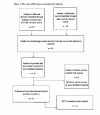Effect of Pharmacological Agents Administered for Attenuating the Extubation Response on the Quality of Extubation: A Systematic Review
- PMID: 31993265
- PMCID: PMC6970457
- DOI: 10.7759/cureus.6427
Effect of Pharmacological Agents Administered for Attenuating the Extubation Response on the Quality of Extubation: A Systematic Review
Abstract
Background Several drugs have been tried to obtund the hemodynamic extubation response but all have variable side effects that may affect the quality of short-term recovery. Objective Our primary objective was to evaluate the effect of pharmacological agents, such as dexmedetomidine, local anesthetics, and so on, administered for attenuating the extubation response on the quality of extubation, as judged by the presence or absence of cough, sedation, and laryngospasm/bronchospasm in adult patients who had undergone general anesthesia. A secondary objective was to evaluate the effect of these drugs on other immediate post-extubation complications such as respiratory depression, desaturation, bradycardia, hypotension, and nausea and vomiting (PONV). Methods This is a systematic review of (randomized controlled trials) RCTs with meta-analysis. The Medical Literature Analysis and Retrieval System Online (MEDLINE), Cumulative Index of Nursing and Allied Health Literature (CINAHL), and Cochrane Central Register of Controlled Trials (CENTRAL) databases were searched for RCTs on the effect of pharmacological agents on both the hemodynamic extubation response as well as the quality of extubation. Results Fourteen out of 24 included studies were subjected to a meta-analysis. The risk of cough was less likely in the intervention group as compared to control groups (OR 0.26, 95% CI 0.15 to 0.46, p<0.00001, I2=35%). Sedation, hypotension (OR= 10.47; 95% CI: 1.86, 58.80, p=0.008, I2=0%), and bradycardia (OR= 6.57; 95% CI: 2.09, 20.64, p=0.001, I2=0%) were reported with dexmedetomidine. Only one study reported laryngospasm with dexmedetomidine and two studies with opioids. Conclusion Dexmedetomidine 0.4 to 0.5 ug/kg was associated with smooth extubation, minimal coughing, no laryngospasm/ bronchospasm, and with stable hemodynamics, without causing respiratory depression, PONV, and desaturation. However, in higher doses (more than 0.5 ug/kg), it caused bradycardia, hypotension, and sedation. Other pharmacological agents, such as local anesthetics, calcium channel blockers, and opioids, did not attenuate cough associated with extubation.
Keywords: complications; cough; dexmedetomidine; endotracheal extubation; lidocaine; opioids.
Copyright © 2019, Salim et al.
Conflict of interest statement
The authors have declared that no competing interests exist.
Figures





Similar articles
-
Effectiveness of dexmedetomidine versus propofol on extubation times, length of stay and mortality rates in adult cardiac surgery patients: a systematic review and meta-analysis.JBI Database System Rev Implement Rep. 2018 May;16(5):1220-1239. doi: 10.11124/JBISRIR-2017-003488. JBI Database System Rev Implement Rep. 2018. PMID: 29762314
-
A double blind, randomized, controlled trial to study the effect of dexmedetomidine on hemodynamic and recovery responses during tracheal extubation.J Anaesthesiol Clin Pharmacol. 2013 Apr;29(2):162-7. doi: 10.4103/0970-9185.111665. J Anaesthesiol Clin Pharmacol. 2013. PMID: 23878434 Free PMC article.
-
Comparison between dexmedetomidine and lidocaine for attenuation of cough response during tracheal extubation: A systematic review and meta-analysis.Indian J Anaesth. 2024 May;68(5):415-425. doi: 10.4103/ija.ija_790_23. Epub 2024 Apr 12. Indian J Anaesth. 2024. PMID: 38764958 Free PMC article.
-
Effect of Intramuscular Dexmedetomidine Administration Before Extubation on Post-Extubation Haemodynamics, Postoperative Sedation, and Analgesic Requirements: A Double Blind Placebo Controlled Study.Asian J Anesthesiol. 2021 Sep 1;59(3):102-110. doi: 10.6859/aja.202109_59(3).0004. Asian J Anesthesiol. 2021. PMID: 34781421 Clinical Trial.
-
Dexmedetomidine for craniotomy under general anesthesia: A systematic review and meta-analysis of randomized clinical trials.J Clin Anesth. 2019 May;54:114-125. doi: 10.1016/j.jclinane.2018.11.001. Epub 2018 Nov 13. J Clin Anesth. 2019. PMID: 30445412
Cited by
-
The epidemiology and phenomenology of non-antipsychotic-induced dystonia: a hybrid systematic-narrative review.Eur Psychiatry. 2025 Feb 10;68(1):e36. doi: 10.1192/j.eurpsy.2025.18. Eur Psychiatry. 2025. PMID: 39925222 Free PMC article.
-
Smooth Extubation and Smooth Emergence Techniques: A Narrative Review.Anesthesiol Res Pract. 2021 Jan 15;2021:8883257. doi: 10.1155/2021/8883257. eCollection 2021. Anesthesiol Res Pract. 2021. PMID: 33510786 Free PMC article. Review.
-
Effect of dexmedetomidine on hemodynamics in patients undergoing hysterectomy: a meta-analysis and systematic review.J Int Med Res. 2021 Aug;49(8):3000605211039809. doi: 10.1177/03000605211039809. J Int Med Res. 2021. PMID: 34433340 Free PMC article.
-
Evaluation and Prevention of Perioperative Respiratory Failure.J Clin Med. 2024 Aug 27;13(17):5083. doi: 10.3390/jcm13175083. J Clin Med. 2024. PMID: 39274295 Free PMC article. Review.
-
Effectiveness of different pharmacological or non-pharmacological interventions on preventing coughing during extubation: a protocol for a systematic review and network meta-analysis.BMJ Open. 2024 Nov 20;14(11):e081592. doi: 10.1136/bmjopen-2023-081592. BMJ Open. 2024. PMID: 39572096 Free PMC article.
References
-
- Effect on postoperative sore throat of spraying the endotracheal tube cuff with benzydamine hydrochloride, 10% lidocaine, and 2% lidocaine. Hung NK, Wu CT, Chan SM, et al. https://www.ncbi.nlm.nih.gov/pubmed/20304980. Anesth Analg. 2010;111:882–886. - PubMed
-
- Fentanyl attenuates cardiovascular responses to tracheal extubation. Nishina K, Mikawa K, Maekawa N, Obara H. Acta Anaesthesiol Scand. 1995;39:85–89. - PubMed
-
- Attenuation of extubation responses: comparison of prior treatment with verapamil and dexmedetomidine. Mistry T, Purohit S, Arora G, Gill N, Sharma J. J Neuroanaesth Crit Care. 2016;3:33–39.
LinkOut - more resources
Full Text Sources
